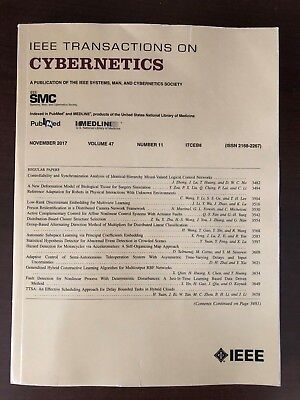Self-Supervised Learning for Intuitive Control of Prosthetic Hand Movements via Sonomyography
IF 9.4
1区 计算机科学
Q1 AUTOMATION & CONTROL SYSTEMS
引用次数: 0
Abstract
As a primary effector of humans, the hand plays a crucial role in many aspects of daily life. Recognizing multidegree-of-freedom hand movements from muscle activity helps infer human motion intentions. Solving this problem has direct applications in prosthetic and exoskeleton control. Here, we propose a self-supervised learning algorithm inspired by muscle synergies to achieve simultaneous estimation of wrist rotation (supination/pronation) and hand grasp (open/close) from sonomyography—the muscle deformation detected by a wearable ultrasound array. Unlike conventional methods collecting both muscle activity and hand kinematics for supervised model calibration, this algorithm only uses unlabeled forearm ultrasound signals for self-supervised wrist and hand movement estimation, where movement labels are auto-generated. The performance of the proposed algorithm was experimentally evaluated with ten participants including an amputee. Offline analysis demonstrated that the proposed algorithm can accurately estimate simultaneous wrist rotation and hand grasp movements (通过超声造影进行自我监督学习以直观控制假手运动
作为人类的主要影响者,手在日常生活的许多方面起着至关重要的作用。从肌肉活动中识别多自由度的手部运动有助于推断人类的运动意图。解决这一问题对假肢和外骨骼控制有直接的应用价值。在这里,我们提出了一种受肌肉协同作用启发的自监督学习算法,以实现从声纳图中同时估计手腕旋转(旋后/旋前)和手握(打开/闭合)-可穿戴超声阵列检测到的肌肉变形。与传统方法收集肌肉活动和手部运动学进行监督模型校准不同,该算法仅使用未标记的前臂超声信号进行自监督手腕和手部运动估计,其中运动标签是自动生成的。该算法的性能进行了实验评估与十个参与者包括一个截肢者。离线分析表明,该算法可以准确估计腕部旋转和手抓动作的同时进行(健全者$r_{\textrm {wrist}}$和截肢者$r_{\textrm {hand}}$分别为0.98和0.94,截肢者$r_{\textrm {wrist}}$和0.98和0.90)。值得注意的是,自监督学习的表现优于监督学习的截肢者。在线实验表明,腕部和手部的预期动作可以实时破译,从而实现对虚拟手的精确控制。本研究将为声速学人机交互开辟一条新的途径。
本文章由计算机程序翻译,如有差异,请以英文原文为准。
求助全文
约1分钟内获得全文
求助全文
来源期刊

IEEE Transactions on Cybernetics
COMPUTER SCIENCE, ARTIFICIAL INTELLIGENCE-COMPUTER SCIENCE, CYBERNETICS
CiteScore
25.40
自引率
11.00%
发文量
1869
期刊介绍:
The scope of the IEEE Transactions on Cybernetics includes computational approaches to the field of cybernetics. Specifically, the transactions welcomes papers on communication and control across machines or machine, human, and organizations. The scope includes such areas as computational intelligence, computer vision, neural networks, genetic algorithms, machine learning, fuzzy systems, cognitive systems, decision making, and robotics, to the extent that they contribute to the theme of cybernetics or demonstrate an application of cybernetics principles.
 求助内容:
求助内容: 应助结果提醒方式:
应助结果提醒方式:


